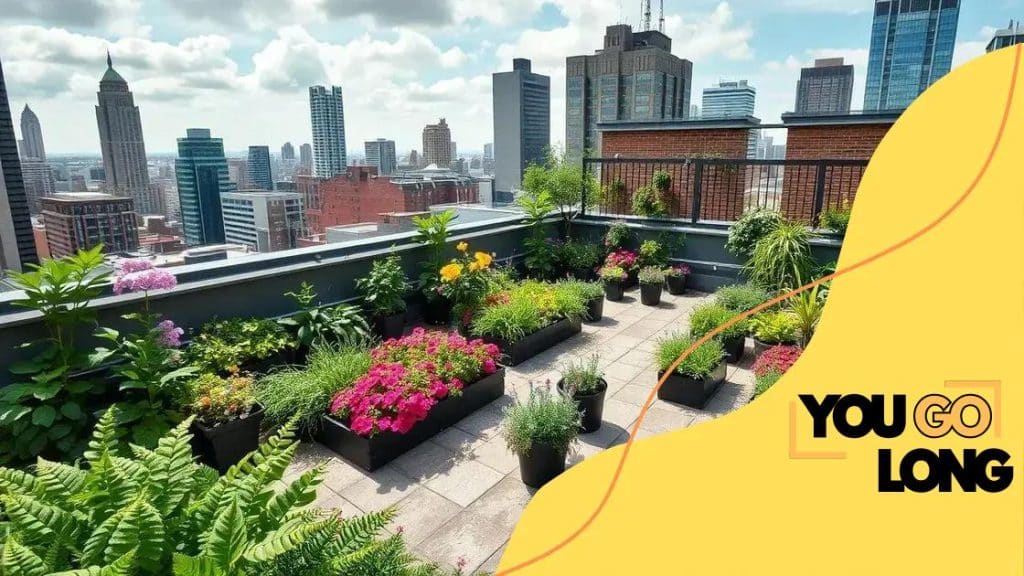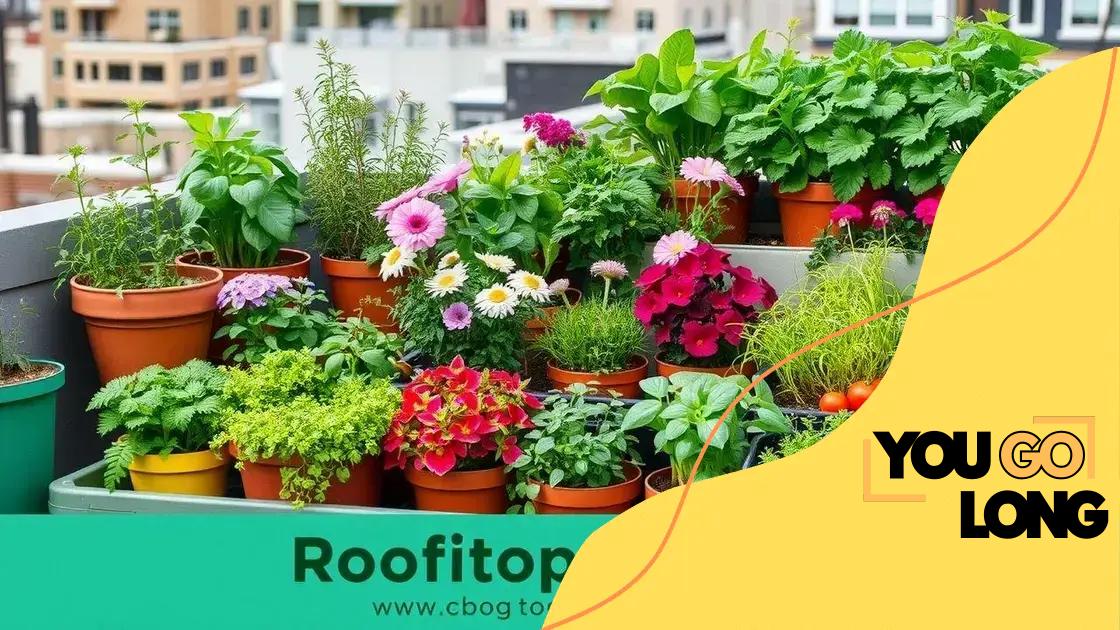How to set up a rooftop garden in the city

Advertisement
How to set up a rooftop garden in the city involves selecting drought-tolerant plants, ensuring proper maintenance, and incorporating unique design elements to create a vibrant and functional urban green space.
How to set up a rooftop garden in the city can be a fun and rewarding project. Imagine having your own green escape above the bustling city streets! Let’s explore how you can turn that dream into reality.
Benefits of rooftop gardens in urban areas
Rooftop gardens offer a variety of benefits for urban dwellers. They not only enhance the beauty of a building but also play a vital role in improving the environment.
Environmental Benefits
One of the most significant advantages of rooftop gardens is their positive impact on the environment. They help reduce the urban heat island effect, a phenomenon where urban areas become significantly warmer than their rural surroundings. By installing a rooftop garden, you can help regulate building temperatures. This minimizes the need for air conditioning, leading to less energy consumption.
Advertisement
Improved Air Quality
Another benefit is the improvement in air quality. Rooftop gardens act as natural air filters by absorbing pollutants and carbon dioxide.
- Enhance urban biodiversity by attracting birds and beneficial insects.
- Provide oxygen and remove harmful gases from the air.
- Create a cooling effect, which helps mitigate climate change.
These factors contribute to a healthier living environment for everyone.
Social and Psychological Benefits
Rooftop gardens also promote social interaction among residents. They offer a space for community gatherings or simply a quiet area to relax. Studies indicate that spending time in green spaces can reduce stress and improve overall well-being. Whether it’s a gathering with friends or enjoying a moment of solitude, the green oasis atop your building can provide much-needed peace in the bustling city.
Advertisement
Furthermore, rooftop gardens can enhance property value. Properties with garden spaces are often more appealing to potential buyers or renters. It shows a commitment to sustainability and appreciation for aesthetic beauty, making them stand out in the real estate market.
Essential materials for rooftop gardening
Setting up a rooftop garden requires some essential materials to ensure success. It’s important to choose the right items to foster a thriving green space.
Growing Medium
The first key element is the growing medium. A good mix of soil is crucial for your plants. Look for a lightweight, well-draining potting mix. You can enhance it by adding organic matter like compost to provide nutrients.
Containers
You’ll also need containers for your plants. Consider using raised beds, pots, or even vertical planters. Ensure they have drainage holes to prevent waterlogging. Selecting the right size will ensure your plants have enough room to grow.
- Terracotta pots are great for moisture retention.
- Plastic containers are lightweight and often more affordable.
- Metal containers can add a sleek, modern look.
When choosing containers, think about how they will match your overall rooftop design.
Watering System
A proper watering system is another crucial element. Depending on the size of your garden, you may want a simple watering can or a more advanced drip irrigation system. This will help keep your plants hydrated without excess waste.
Additionally, consider including a few gardening tools. Basic tools like a trowel, pruners, and a hand rake will make gardening tasks easier. It’s also wise to have gloves to protect your hands while working.
Lastly, consider trellises or supports for climbing plants. They not only save space but also allow your plants to get more sunlight, enhancing growth. Remember, planning with these essential materials will set the foundation for a successful rooftop garden.
Choosing the right plants for your rooftop garden

Selecting the right plants for your rooftop garden is essential for creating a thriving green space. You’ll want to choose plants that can adapt well to the rooftop environment.
Consider Sunlight and Wind
Rooftops often receive full sunlight and strong winds, so it’s crucial to select plants that can withstand these conditions. Look for drought-tolerant varieties that are well-suited for direct sun. Succulents and herbs are excellent options, as they require less water and can flourish in bright light.
Types of Suitable Plants
Here are several types of plants you might consider for your rooftop garden:
- Herbs: Basil, rosemary, and thyme thrive in sunny conditions.
- Flowers: Marigolds, petunias, and zinnias add vibrant colors and attract pollinators.
- Vegetables: Tomatoes, peppers, and lettuce are great choices for rooftop gardening.
- Shrubs: Low-maintenance options include lavender and boxwood for structure.
When selecting plants, think about their height and spread. Taller plants can provide shade for shorter ones, creating a layered effect that enhances your garden’s visual appeal.
Soil and Container Considerations
Using lightweight soil is vital for rooftop gardens. Ensure that the containers are deep enough to accommodate root growth but also light enough not to damage the roof. Don’t forget to use pots with proper drainage to prevent water from accumulating. By choosing the right plants and considering their growing requirements, you can create an ideal rooftop garden that thrives in urban settings.
Maintenance tips for thriving rooftop gardens
Proper maintenance is key to ensuring that your rooftop garden remains vibrant and thriving. It’s important to establish a routine that addresses watering, feeding, and general care.
Regular Watering
One of the most critical aspects of rooftop garden maintenance is watering. Rooftop gardens can dry out quickly due to exposure to sunlight and wind. Water your plants early in the morning or late in the afternoon to prevent evaporation. Use a moisture meter to check when your plants need water. Pay attention to the specific water needs of your plants – some may require more than others.
Fertilizing Your Plants
Plants in containers need extra nutrients since they have limited access to soil. Consider using a slow-release fertilizer every 4-6 weeks during the growing season. Organic options, like compost tea or worm castings, can also enrich your soil naturally.
- Test your soil regularly to find out nutrient levels.
- Adjust your feeding routine based on plant growth stages.
- Be cautious not to over-fertilize, as it can harm plants.
Additionally, pruning your plants helps promote healthy growth. Regularly remove dead or yellowing leaves to encourage new growth and improve air circulation.
Pest and Disease Management
Keep an eye out for pests that can damage your plants. Aphids and spider mites are common nuisances in rooftop gardens. If you notice an infestation, treat it promptly using insecticidal soap or neem oil. Regularly inspect your plants for any signs of disease, and ensure proper air circulation to prevent fungal growth.
Lastly, be flexible with your maintenance schedule. Changes in weather can affect your plant needs. During hot, dry spells, you may need to water more frequently. Being attentive and adapting will help keep your rooftop garden healthy.
Design ideas to make your rooftop garden unique
Creating a unique rooftop garden is all about expressing your personal style while considering functionality. You can use various design ideas to turn your rooftop into a beautiful urban oasis.
Incorporate Vertical Gardening
Vertical gardening is an excellent way to maximize space in your rooftop garden. You can install wall planters or vertical racks filled with herbs and flowers. This not only utilizes vertical space but also adds dimension to your garden. It creates a stunning backdrop and can be a focal point of your design.
Use Colorful Containers
Selecting colorful containers can add vibrancy to your rooftop garden. Terracotta pots, ceramic containers, or even repurposed items can make great planters. Here are some ideas:
- Mix and match: Combine different sizes and colors for a dynamic look.
- Theme it: Choose containers that match your garden’s theme, like rustic or modern.
- DIY options: Consider painting or decorating your old pots to refresh their look.
By varying the container styles and colors, you can create a lively atmosphere that reflects your personality.
Add Seating and Decorative Elements
Incorporating comfortable seating can transform your rooftop space into an area for relaxation and socializing. Consider adding a small table and chairs or even lounge chairs for a cozy feel. Incorporate decorative elements like lanterns, fairy lights, or outdoor rugs to enhance the ambiance.
Additionally, consider features like a water fountain or a small pond. These elements can introduce soothing sounds and movement, further enhancing the garden’s charm.
Create Microclimates
Using larger plants to provide shade can create little microclimates on your rooftop. This allows you to grow plants that prefer cooler conditions. Consider grouping taller plants together to shield smaller or more delicate ones from direct sunlight.
By embracing these design ideas, you can make your rooftop garden not just unique but a true extension of your home. Personal touches and creative arrangements will result in a beautiful and enjoyable space for you and your guests.
Conclusion: Creating a rooftop garden is a rewarding project that enhances both beauty and functionality in urban spaces. By carefully selecting the right plants, ensuring proper maintenance, and incorporating unique design elements, you can transform any rooftop into a green oasis. These gardens not only provide a serene escape from the hustle and bustle of city life but also contribute positively to the environment. Whether through growing herbs, flowers, or vegetables, your rooftop garden can flourish with a little creativity and care. Embrace the journey of gardening, and enjoy the unique space you’ve created.
FAQ – Frequently Asked Questions about Rooftop Gardening
What types of plants are best for rooftop gardens?
Drought-tolerant plants, herbs, and colorful flowers are great choices for rooftop gardens due to their ability to thrive in direct sunlight and wind.
How often should I water my rooftop garden?
Watering frequency depends on the plants and weather, but it’s advisable to check the soil moisture daily, especially during hot and dry conditions.
What materials do I need for a rooftop garden?
Essential materials include lightweight soil, containers with drainage, a watering system, and basic gardening tools.
How can I make my rooftop garden unique?
Incorporate vertical gardening, colorful containers, comfortable seating, and decorative elements to create a personalized and inviting rooftop space.





